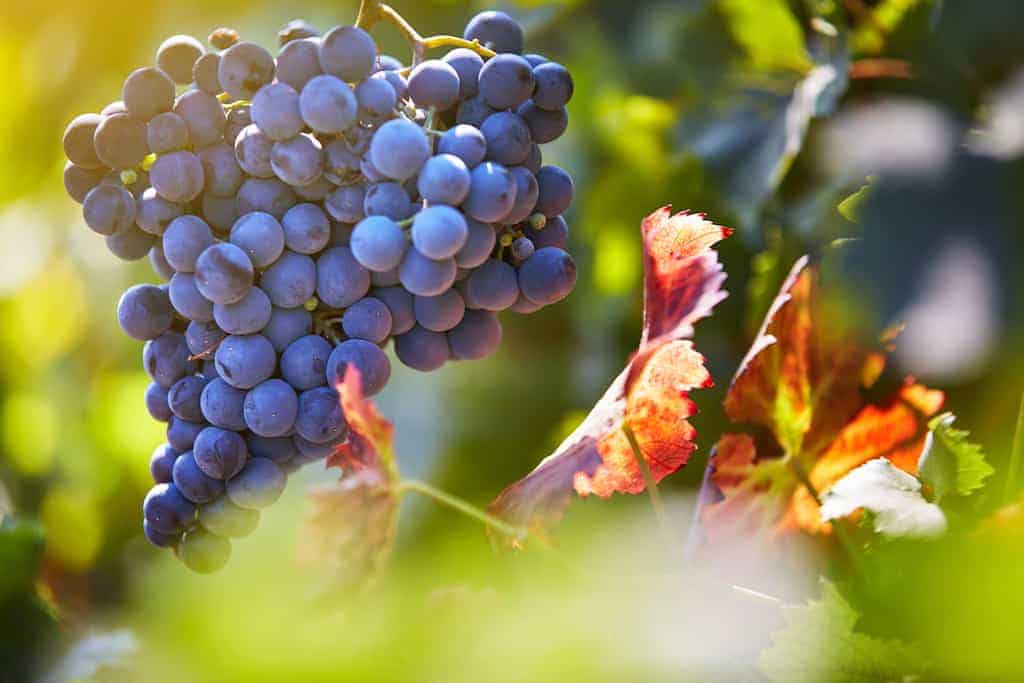Syrah is a black grape variety that most commonly makes medium to full-bodied dry red wine. In this guide, we’ll discuss the food pairings and tasting notes associated with the Syrah grape variety. Plus, we’ll learn how climate plays a role in what Syrah will ultimately taste like. Syrah is also known as Shiraz, among several other varietal and regional names.
IN THIS GUIDE:
What Does The Syrah Grape Taste Like?
Syrah is a big-bodied, dry red wine that tends to shine its brightest on the opening palate. Not only is Syrah flavor-packed, but it’s also one of the darkest-colored inky wines you can find. Deep purple in hue with not much translucency, Syrah’s violet, and velvety elegance is backed by big fruit and crunchy spice.
Syrah grown in warmer climates yields a bigger-bodied wine with juicier fruit, smooth tannins, and secondary spice notes. The fruit notes tend to be plum, blackberry, black cherry, and blueberry.
Syrah grown in cooler climates yields less jammy fruit, bolder spices, more earthy complexities, and stricter tannins. The fruit notes tend to be black currant, dragon fruit, and blackberry.
These flavors are typically bolder on the opening palate, with a softer texture, viscosity and spice leading the way out. Note that while these are the generalities of Syrah flavor, climate plays a critical role in determining the kind of flavor experienced with Syrah wines.
Earth and mineral notes for Syrah tend to include cold stone, mixed gravel, limestone, shale, forest floor, and clove, and there can be additional notes of violet, cola, barnyard, black pepper, smoke, licorice, and cacao.
Syrah Food Pairings
Syrah starts out with a bit of a punch on the opening palate. As such, we don’t want to be eating food alongside Syrah that is bland in any way. The first thing that comes to mind is dry-rub brisket or well-seasoned pork, which is both juicy and savory. Syrah, especially New World bottlings, can be juicy, savory and spicy — especially when blooms of black and blue fruit punch are backed by tannin and cracked pepper spice.
To tone it down a bit, try slow-roasted duck or quail. Don’t be afraid to utilize the spice cabinet.
Other Syrah food pairings include any pizza with meat on it, garlic mashed potatoes, grilled meats with dry rub, grilled veggies, and venison.
Syrah is ideal for holiday dinners or special events where guests want deep flavor to match colorful conversation.
Climate and Terroir for the Syrah Grape
Syrah is grown all over the world today, in both hot and cool climates with varying soil compositions. Some of the more well-known growing regions include France’s Rhône Valley, Barossa Valley in Australia, Paso Robles in California, and Washington State.
Recent DNA analysis has led scientists to discover that Syrah was born out of two lesser-known grape varieties from southeastern France — Mondeuse blanche and Dureza.
Terroir related factors play a critical role as to what a Syrah will taste like. Many vintners will place their Syrah grape vines along hillsides or at the top of slopes. This elevated positioning allows water to drain more efficiently thanks gravity and more stones in the soil. All of which limit Syrah yields and produce bolder flavored grapes.
Speaking very generally, the common perception is that New World Syrah is fruiter and bigger bodied, while Old World is more complex with noticeable earth and firm tannins. This is true for the most part, but it really comes down to climate, rather than Old or New.
General Rules of Thumb for Climate and Syrah
- Syrah grown in warmer climates yields a bigger-bodied wine with juicier fruit, smooth tannins and secondary spice notes.
- Syrah grown in cooler climates yields less jammy fruit, bolder spices, more earthy complexities and stricter tannins.
How is Syrah Aged?
Old World Syrahs tend to age very well, especially those from the northern Rhône appellations of St-Joseph and Hermitage. Many southern Rhône regions have Syrah blended in with other grapes and, with the exception of Châteauneuf-du-Pape, those are mostly meant to be enjoyed young. Most Rhône producers will use oak barrels but only to smooth out the wine, not to impart a strong oak or toast note. (Syrah is so interesting, that would be a disservice!)
Some New World producers also produce age-worthy Syrahs, particularly around Santa Barbara County in California and within Australia’s Barossa Valley. Most wines do see oak treatment and are bigger, more fruit forward than their Old World counterparts.
Syrah Grape Taste Profile
Common Flavors and Aromas
- Fruit: Black & Blue
- Warmer Climate: Plum, Blackberry, Black Cherry, Blueberry
- Cooler Climate: Black Currant (Cassis), Dragon fruit, Blackberry
- Earth & Mineral Notes: Cold Stone, Mixed Gravel, Limestone, Shale, Forest Clove
- Additional Complexities: Violet, Cola, Barnyard Saddle, Cracked Black Pepper, Smoke, Licorice, Cacao
Structure
- Body: Medium-Full
- Sugar: Dry
- Tannins: Medium Plus, High
- Acid: Medium Plus
- Alcohol: Medium (12.0%-14.0% ABV)
- Finish: Medium-Long
Terroir
- Soil: Gravel, Clay, Limestone, Shale
- Climate: Varied (Hot – Cool)
- Notable Regions: Barossa Valley, Australia | Hawk’s Bay, Australia | Rhone, France | Lodi, California | Washington State, USA
Fun Facts about Syrah
- Syrah was called Hermitage in Australia until the late 1980s – now it’s called Shiraz.
- Although Shiraz is also the name of an ancient Persian city, there is no conclusive connection between the grape and the city.
- A group of California winemakers calling themselves the Rhône Rangers helped popularize Syrah in the 1970s.
Try these delicious Syrah-based wines from around the world:
- Guigal, ‘La Turque,’ Côte Rôtie, Rhône, France
- Alain Voge, ‘Les Chailles,’ Cornas, Rhône
- Château Maris, ‘Les Planels,’ Minervois, Languedoc, France
- Melville, Estate, Sta. Rita Hills, Santa Barbara County, California
- Radio-Coteau, ‘Las Colinas,’ Sonoma Coast, California
- Yangarra, Estate Vineyard, ‘Ironheart,’ McLaren Vale, Australia
- Penfolds, Bin 28, Australia
